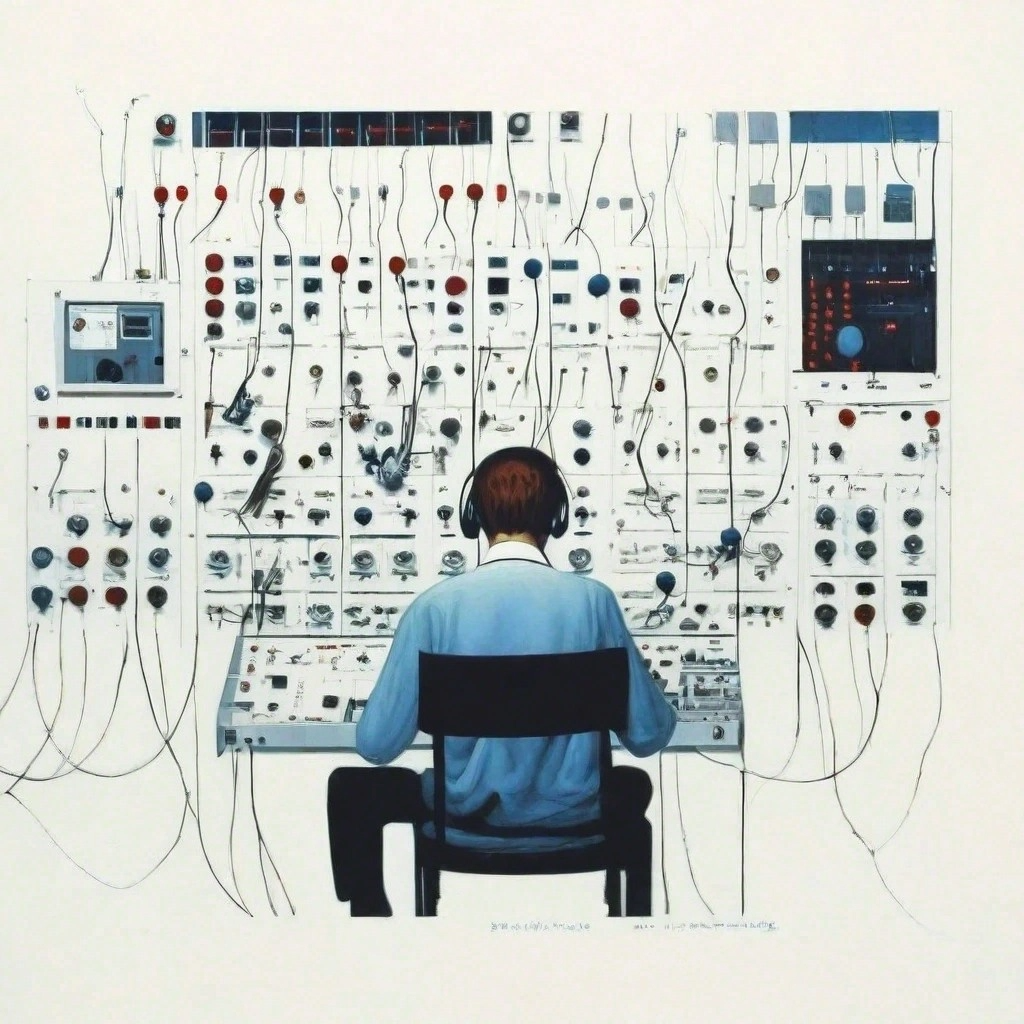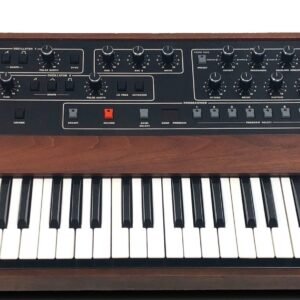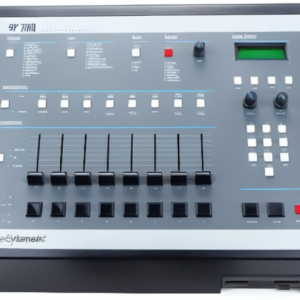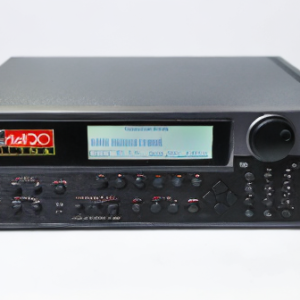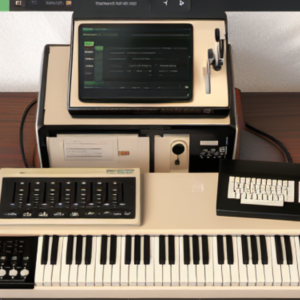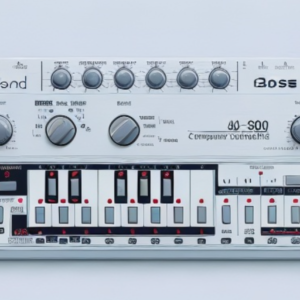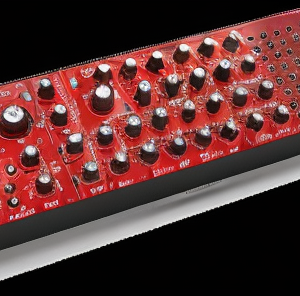EMS VCS3
The EMS VCS3, also known as the Voltage Controlled Studio 3, stands as an icon in the realm of electronic music equipment. Developed by the UK-based company Electronic Music Studios (EMS), the VCS3 emerged in the late 1960s, precisely in 1969, amidst a pivotal era of experimental electronic music exploration. Its creation was spearheaded by Peter Zinovieff, Tristram Cary, and David Cockerell, who sought to provide musicians and sound designers with a revolutionary tool for sound synthesis and manipulation.
The VCS3 was born into a time of burgeoning experimentation in electronic music, where synthesizers were evolving from large, impractical modular systems into more compact, versatile units. In this context, the VCS3 represented a groundbreaking shift, offering musicians a portable and relatively affordable synthesizer with an unprecedented level of flexibility and sonic possibilities.
At its core, the VCS3 utilized a modular patch-based design, allowing users to interconnect various modules using patch cables to sculpt and shape sound. This modular approach empowered musicians to explore new sonic territories, from ethereal drones to quirky bleeps and bloops, fostering a culture of sonic experimentation and innovation.
The design of the VCS3 was ahead of its time, featuring a distinctive futuristic aesthetic with its iconic circular control panel adorned with colorful knobs and switches. This unique layout not only facilitated intuitive hands-on control but also contributed to the instrument’s iconic status, making it instantly recognizable among musicians and electronic music enthusiasts.
Throughout its lifespan, the EMS VCS3 found its way into the hands of pioneering musicians, composers, and sound artists who embraced its revolutionary capabilities. From Pink Floyd’s psychedelic soundscapes to the avant-garde compositions of Karlheinz Stockhausen, the VCS3 left an indelible mark on the landscape of electronic music, shaping the sonic identity of an entire generation of artists.
Despite being introduced over five decades ago, the EMS VCS3 continues to captivate and inspire musicians and electronic music enthusiasts worldwide. Its enduring legacy speaks to its timeless appeal and its status as a true icon in the history of electronic music technology. As we delve deeper into the design, features, and sonic capabilities of the EMS VCS3, we uncover a treasure trove of sonic possibilities waiting to be explored and experienced.
Design and Features of the EMS VCS3:
The design and features of the EMS VCS3 reflect a pioneering approach to synthesizer technology, offering a unique combination of flexibility, portability, and sonic versatility. Let’s delve into the key aspects of its design and explore the features that have made it a legendary instrument in the world of electronic music:
1. Modular Patch-Based Design:
At the heart of the EMS VCS3 is its modular patch-based architecture, which allows for flexible routing and modulation of audio signals. The instrument consists of various modules, including oscillators, filters, envelope generators, and voltage-controlled amplifiers (VCAs), which can be interconnected using patch cables. This modular approach empowers users to create complex and evolving sounds by routing signals in creative ways, making the VCS3 a playground for sonic experimentation.
2. Compact and Portable Form Factor:
Unlike its predecessors, which often required extensive studio space and cumbersome setups, the EMS VCS3 was designed to be compact and portable. Its lightweight construction and integrated carrying handles made it ideal for both studio use and live performances, allowing musicians to take their sonic explorations wherever they went. This portability played a significant role in popularizing the VCS3 among touring musicians and bands seeking to integrate electronic sounds into their performances.
3. Iconic Control Panel Layout:
One of the most distinctive features of the EMS VCS3 is its iconic control panel layout, characterized by a circular design adorned with colorful knobs, switches, and input/output sockets. This intuitive layout not only provides easy access to the instrument’s various parameters but also encourages hands-on experimentation and improvisation. Each control element is thoughtfully positioned to facilitate quick and intuitive sound shaping, making the VCS3 a joy to interact with for musicians and sound designers alike.
4. Voltage Controlled Oscillators (VCOs):
The EMS VCS3 features three voltage-controlled oscillators (VCOs), each capable of generating a variety of waveforms, including sine, triangle, sawtooth, and square waves. These oscillators serve as the primary sound sources in the synthesizer, allowing users to create a wide range of tones and timbres. The VCOs can be independently tuned and modulated, offering endless possibilities for sonic experimentation and exploration.
5. Unique Filter Section:
Central to the sonic character of the EMS VCS3 is its unique filter section, which includes a voltage-controlled low-pass filter (VCF) with resonance control. The filter can impart a distinctive warmth and character to the sound, ranging from smooth and creamy to aggressive and biting. By modulating the filter cutoff and resonance parameters, users can sculpt evolving textures and timbres with ease, adding depth and dimension to their sonic creations.
6. Flexible Modulation Options:
In addition to its oscillator and filter sections, the EMS VCS3 offers a range of modulation options to shape and manipulate sound. These include envelope generators, voltage-controlled amplifiers (VCAs), and a dedicated joystick controller for real-time modulation. By routing modulation sources to various parameters, users can add movement, dynamics, and expression to their sounds, creating rich and evolving sonic landscapes.
7. Built-in Reverb and Spring Reverb Tank:
To further enhance its sonic capabilities, the EMS VCS3 features a built-in reverb unit, providing lush and immersive spatial effects. Additionally, some versions of the VCS3 include an optional spring reverb tank, adding a distinctive character and texture to the instrument’s sound. These onboard effects contribute to the VCS3’s versatility and make it well-suited for a wide range of musical styles and genres.
Overall, the design and features of the EMS VCS3 reflect a commitment to innovation and creativity, offering musicians and sound designers a powerful tool for sonic exploration and experimentation. From its modular patch-based architecture to its iconic control panel layout and unique sonic character, the VCS3 continues to inspire and captivate generations of electronic music enthusiasts with its timeless appeal and limitless potential.
Sound Generation of the EMS VCS3:
The EMS VCS3, renowned for its groundbreaking sound generation capabilities, offers a rich palette of sonic possibilities that have defined its legacy in the world of electronic music. Let’s explore the core elements of its sound generation and delve into the unique characteristics that have made it a staple in the arsenal of musicians, composers, and sound designers:
1. Voltage-Controlled Oscillators (VCOs):
At the heart of the EMS VCS3’s sound generation are its three voltage-controlled oscillators (VCOs), which serve as the primary sources of audio signals. These oscillators produce a variety of waveforms, including sine, triangle, sawtooth, and square waves, offering a diverse range of tonal possibilities. Users can independently adjust the frequency, waveform, and amplitude of each oscillator, allowing for complex harmonic textures and timbral variations.
2. Modular Patching and Signal Routing:
One of the defining features of the EMS VCS3 is its modular patch-based design, which enables users to creatively route and modulate audio signals. By connecting patch cables between various modules, such as oscillators, filters, and envelope generators, users can sculpt and shape sound in real-time. This flexible signal routing allows for dynamic interactions between different sound sources and processing units, fostering endless possibilities for experimentation and sonic exploration.
3. Filter Section:
The EMS VCS3 features a voltage-controlled low-pass filter (VCF) with resonance control, which plays a crucial role in shaping the character of its sound. The filter can attenuate higher frequencies while allowing lower frequencies to pass through, resulting in a warm and organic tone. By modulating the filter cutoff and resonance parameters, users can achieve a wide range of tonal variations, from smooth and mellow to bright and aggressive, adding depth and richness to their sonic creations.
4. Envelope Generators:
Envelope generators play a vital role in shaping the dynamics and evolution of sounds generated by the EMS VCS3. The instrument includes multiple envelope generators, which control parameters such as amplitude, filter cutoff, and modulation depth over time. By shaping the attack, decay, sustain, and release stages of these envelopes, users can create expressive and dynamic soundscapes with varying levels of intensity and movement.
5. Real-Time Modulation:
The EMS VCS3 offers extensive modulation capabilities, allowing users to introduce dynamic changes and movement to their sounds in real-time. This includes dedicated modulation sources such as LFOs (Low-Frequency Oscillators) and the joystick controller, which can be used to modulate parameters such as pitch, filter cutoff, and oscillator frequency. By manipulating these modulation sources, users can create evolving textures, rhythmic patterns, and spatial effects, adding depth and complexity to their compositions.
6. Built-in Effects:
To further enhance its sonic capabilities, some versions of the EMS VCS3 include built-in effects such as reverb and spring reverb, adding spatial depth and texture to the sound. These onboard effects can be used to create immersive soundscapes, emulate acoustic spaces, or add character and coloration to the audio signal. Combined with the instrument’s modular patching capabilities, these effects contribute to the VCS3’s versatility and appeal across a wide range of musical genres and styles.
In summary, the EMS VCS3’s sound generation capabilities are characterized by their versatility, expressiveness, and sonic richness. From its voltage-controlled oscillators and modular patching system to its flexible modulation options and built-in effects, the VCS3 offers a powerful platform for sonic experimentation and exploration, inspiring musicians and sound designers to push the boundaries of electronic music creativity.
Notable Users and Influences of the EMS VCS3:
The EMS VCS3 has left an indelible mark on the landscape of electronic music, shaping the sonic identity of numerous artists, composers, and bands across a wide range of genres. Let’s explore some of the notable users and influences of this iconic synthesizer:
1. Pink Floyd:
Perhaps one of the most iconic users of the EMS VCS3, Pink Floyd integrated the synthesizer prominently into their psychedelic and progressive rock soundscapes. Richard Wright, the band’s keyboardist, utilized the VCS3 to create otherworldly textures, atmospheric drones, and innovative sound effects, contributing to the band’s groundbreaking albums such as “The Dark Side of the Moon” and “Wish You Were Here.”
2. Brian Eno:
Renowned for his pioneering work in ambient music and electronic soundscapes, Brian Eno is another notable user of the EMS VCS3. Eno’s use of the synthesizer, particularly during his tenure with the band Roxy Music and in his solo career, helped redefine the possibilities of electronic music production. His innovative approach to sound manipulation and exploration laid the groundwork for generations of electronic musicians to come.
3. Tangerine Dream:
The influential German electronic music group Tangerine Dream embraced the EMS VCS3 as a central element of their sonic palette. Utilizing the synthesizer’s modular patching capabilities, Tangerine Dream crafted immersive soundscapes, pulsating rhythms, and ethereal textures that pushed the boundaries of electronic music experimentation. Their groundbreaking albums such as “Phaedra” and “Rubycon” showcase the VCS3’s unique sonic contributions to the electronic music landscape.
4. Karlheinz Stockhausen:
As a pioneering figure in the realm of electronic music composition, Karlheinz Stockhausen utilized the EMS VCS3 in several of his avant-garde compositions. Embracing the synthesizer’s modular architecture and innovative sound generation capabilities, Stockhausen explored new sonic territories, pushing the boundaries of conventional musical structures and concepts. His collaborations with EMS founder Peter Zinovieff further cemented the VCS3’s reputation as a tool for cutting-edge electronic music experimentation.
5. Delia Derbyshire:
Delia Derbyshire, best known for her groundbreaking work at the BBC Radiophonic Workshop, made extensive use of the EMS VCS3 in her pioneering electronic compositions. As one of the earliest electronic music composers, Derbyshire pushed the boundaries of sound manipulation and synthesis, utilizing the VCS3 to create innovative soundtracks, experimental pieces, and iconic electronic music themes, including the legendary “Doctor Who” theme.
6. David Bowie:
David Bowie, the visionary musician and artist, incorporated the EMS VCS3 into his eclectic and innovative musical endeavors. From the experimental textures of albums like “Low” and “Heroes” to the avant-garde soundscapes of “Lodger,” Bowie’s collaboration with producer Brian Eno showcased the VCS3’s ability to add depth, atmosphere, and sonic intrigue to his diverse repertoire.
7. Jean-Michel Jarre:
The French electronic music pioneer Jean-Michel Jarre embraced the EMS VCS3 as a key instrument in his expansive and cinematic compositions. Jarre’s groundbreaking albums, such as “Oxygène” and “Equinoxe,” feature the VCS3’s distinctive sound prominently, with its ethereal drones, pulsating rhythms, and futuristic textures contributing to the immersive sonic landscapes that define his music.
These are just a few examples of the notable users and influences of the EMS VCS3, whose innovative sound generation capabilities have left an enduring legacy in the world of electronic music. From psychedelic rock to ambient, avant-garde to experimental, the VCS3’s influence continues to resonate across generations of musicians, inspiring new waves of sonic exploration and creativity.
Impact and Legacy of the EMS VCS3:
The EMS VCS3 stands as a pioneering instrument that has had a profound impact on the evolution of electronic music, leaving behind a rich legacy that continues to resonate with musicians, composers, and sound designers worldwide. Let’s explore the enduring impact and legacy of this iconic synthesizer:
1. Revolutionizing Electronic Music Production:
The EMS VCS3 played a pivotal role in revolutionizing electronic music production by providing musicians and sound designers with a powerful tool for sound synthesis and manipulation. Its modular patch-based design and flexible routing capabilities empowered users to explore new sonic territories, pushing the boundaries of conventional music composition and production.
2. Shaping Musical Genres and Styles:
The distinctive sound of the EMS VCS3 has left an indelible mark on a wide range of musical genres and styles, from psychedelic rock and experimental electronica to ambient music and avant-garde composition. Its unique sonic character, characterized by ethereal drones, pulsating rhythms, and otherworldly textures, has become synonymous with the sound of electronic music exploration.
3. Inspiring Innovation and Creativity:
The EMS VCS3 has inspired generations of musicians, composers, and sound artists to push the boundaries of creativity and experimentation in electronic music. Its modular architecture and intuitive interface have encouraged hands-on exploration and improvisation, fostering a culture of innovation and sonic discovery among users.
4. Pioneering Sound Design Techniques:
The EMS VCS3 played a significant role in pioneering new sound design techniques and approaches, from granular synthesis and waveshaping to voltage-controlled modulation and stochastic synthesis. Its modular nature allowed users to create complex and evolving soundscapes with unprecedented levels of control and precision, laying the groundwork for future advancements in electronic music technology.
5. Cultural and Artistic Influence:
Beyond its technical innovations, the EMS VCS3 has had a profound cultural and artistic influence, shaping the sonic landscapes of film, television, and multimedia art. Its distinctive sound has been featured in countless film scores, television soundtracks, and experimental art installations, cementing its status as a cultural icon in the realm of electronic music technology.
6. Enduring Popularity and Collector’s Item:
Despite being introduced over five decades ago, the EMS VCS3 continues to enjoy enduring popularity among musicians, collectors, and electronic music enthusiasts. Its scarcity and historical significance have elevated it to the status of a highly sought-after collector’s item, with vintage units commanding premium prices on the resale market.
7. Continued Innovation and Evolution:
While the original EMS VCS3 may be a relic of the past, its legacy lives on in modern synthesizers, software instruments, and digital audio workstations that draw inspiration from its pioneering design and sound. The spirit of innovation and exploration embodied by the VCS3 continues to drive advancements in electronic music technology, ensuring its relevance in the ever-changing landscape of music production and performance.
In summary, the EMS VCS3’s impact and legacy extend far beyond its status as a groundbreaking synthesizer. It has shaped the sonic identity of electronic music, inspired generations of musicians and sound designers, and contributed to the cultural and artistic fabric of our society. As a symbol of innovation, creativity, and sonic exploration, the VCS3 remains a timeless icon in the history of electronic music technology.
Collector's Value and Market Trends of the EMS VCS3:
The EMS VCS3 holds a revered status among collectors and enthusiasts in the world of vintage synthesizers, commanding significant value on the resale market. Let’s delve into the factors that contribute to its collector’s value and explore the current market trends surrounding this iconic instrument:
1. Historical Significance:
As one of the pioneering synthesizers in the history of electronic music, the EMS VCS3 holds immense historical significance. Its role in revolutionizing electronic music production and shaping the sonic landscapes of numerous musical genres has cemented its status as a highly coveted collector’s item among enthusiasts and collectors alike.
2. Limited Availability:
The EMS VCS3 was produced in relatively limited quantities during its production run, contributing to its scarcity and rarity on the vintage synthesizer market. As a result, vintage units are highly sought after by collectors seeking to own a piece of electronic music history, further driving up their collector’s value.
3. Iconic Design and Aesthetic Appeal:
The distinctive design and aesthetic appeal of the EMS VCS3, characterized by its circular control panel adorned with colorful knobs and switches, contribute to its allure as a collector’s item. Its futuristic appearance and innovative layout evoke a sense of nostalgia and admiration among fans of vintage synthesizers, adding to its collector’s value.
4. Demand from Musicians and Artists:
Beyond its status as a collector’s item, the EMS VCS3 remains a coveted instrument among musicians, composers, and sound artists who value its unique sonic capabilities and expressive potential. This ongoing demand from music professionals seeking to integrate vintage synthesizers into their productions further fuels interest in the EMS VCS3 and influences its market value.
5. Price Appreciation and Investment Potential:
Over the years, the collector’s value of the EMS VCS3 has seen steady appreciation, reflecting its enduring appeal and significance in the realm of electronic music technology. Vintage units in good condition, particularly those with original components and documentation, can command premium prices on the resale market, making them attractive investments for collectors looking to preserve and appreciate the legacy of this iconic synthesizer.
6. Market Trends and Availability:
The availability of EMS VCS3 units on the resale market fluctuates depending on factors such as supply, demand, and overall market conditions. While vintage units occasionally surface for sale through online marketplaces, auctions, and specialized vintage synthesizer dealers, finding one in pristine condition can be a challenge due to their age and rarity.
7. Community and Collector’s Circles:
The EMS VCS3 has a dedicated community of enthusiasts, collectors, and aficionados who actively engage in discussions, trading, and sharing of information related to the instrument. This vibrant community contributes to the preservation and appreciation of the EMS VCS3’s legacy, fostering a sense of camaraderie and mutual appreciation among collectors and fans.
In summary, the EMS VCS3’s collector’s value is driven by its historical significance, limited availability, iconic design, ongoing demand from musicians, and appreciation as an investment asset. As a symbol of innovation and creativity in the realm of electronic music, the EMS VCS3 continues to captivate collectors and enthusiasts, ensuring its enduring legacy in the annals of music technology history.
Innovations and Contributions of the EMS VCS3:
The EMS VCS3 stands as a pioneering instrument that has made significant innovations and contributions to the field of electronic music technology. Let’s explore some of the key innovations and contributions of this iconic synthesizer:
1. Modular Patch-Based Design:
One of the most significant innovations of the EMS VCS3 is its modular patch-based design, which revolutionized the way musicians and sound designers interacted with synthesizers. By allowing users to interconnect various modules using patch cables, the VCS3 empowered them to create complex and evolving sounds through flexible signal routing and modulation. This modular approach laid the groundwork for future synthesizer designs and became a hallmark of electronic music production.
2. Portability and Compact Form Factor:
At a time when synthesizers were often large, cumbersome, and studio-bound, the EMS VCS3 introduced a new paradigm of portability and compactness. Its lightweight construction and integrated carrying handles made it ideal for both studio use and live performances, enabling musicians to take their electronic sounds on the road and integrate them into their live shows. This portability expanded the reach of electronic music and facilitated new modes of musical expression.
3. Integrated Voltage-Controlled Oscillators (VCOs):
The EMS VCS3 featured three voltage-controlled oscillators (VCOs) as its primary sound sources, each capable of generating a variety of waveforms. These integrated VCOs provided users with a rich palette of tonal possibilities, from smooth and harmonic to gritty and abrasive, allowing for a wide range of sonic exploration and experimentation. The VCOs served as the foundation for creating diverse and dynamic sounds on the VCS3.
4. Flexible Signal Processing and Modulation:
One of the key strengths of the EMS VCS3 lies in its flexible signal processing and modulation capabilities. Users could modulate various parameters such as oscillator frequency, filter cutoff, and amplifier level using dedicated envelope generators, voltage-controlled amplifiers (VCAs), and low-frequency oscillators (LFOs). This flexibility allowed for dynamic sound shaping and modulation, enabling users to create evolving textures, rhythmic patterns, and expressive timbres.
5. Unique Filter Section with Resonance Control:
Central to the sonic character of the EMS VCS3 is its unique filter section, which includes a voltage-controlled low-pass filter (VCF) with resonance control. The filter can impart a distinctive warmth and character to the sound, ranging from smooth and creamy to aggressive and biting. By modulating the filter cutoff and resonance parameters, users could achieve a wide range of tonal variations, adding depth and richness to their sonic creations.
6. Onboard Effects and Spatial Processing:
Some versions of the EMS VCS3 included built-in effects such as reverb and spring reverb, enhancing its sonic capabilities and spatial processing capabilities. These onboard effects added depth, dimension, and character to the instrument’s sound, allowing users to create immersive soundscapes, emulate acoustic spaces, and add coloration to their compositions. The integration of effects within the synthesizer itself expanded its sonic palette and creative potential.
7. Cultural and Artistic Influence:
Beyond its technical innovations, the EMS VCS3 has had a profound cultural and artistic influence, shaping the sonic landscapes of music, film, television, and multimedia art. Its distinctive sound has been featured in countless recordings, soundtracks, and experimental compositions, contributing to the sonic identity of various musical genres and artistic movements. The VCS3’s legacy as a tool for sonic exploration and expression continues to inspire musicians and artists worldwide.
In summary, the EMS VCS3’s innovations and contributions have played a pivotal role in advancing the field of electronic music technology, shaping the way musicians interact with synthesizers and pushing the boundaries of sonic exploration and creativity. From its modular patch-based design to its flexible signal processing capabilities and unique sonic character, the VCS3 remains a landmark instrument in the history of electronic music.
Community and Support for the EMS VCS3:
The EMS VCS3 has fostered a vibrant and dedicated community of enthusiasts, musicians, collectors, and artists who share a passion for this iconic synthesizer. Let’s explore the various aspects of community and support surrounding the EMS VCS3:
1. Online Forums and Communities:
The EMS VCS3 community thrives on online forums, social media platforms, and dedicated websites where users can share knowledge, exchange tips and techniques, and engage in discussions about the instrument. These online communities serve as valuable resources for both experienced users and newcomers seeking guidance and support.
2. User Groups and Meetups:
In addition to online interactions, EMS VCS3 enthusiasts often organize user groups, meetups, and gatherings to connect with fellow users in person. These events provide opportunities for hands-on exploration, collaborative jam sessions, and networking with like-minded individuals who share a passion for electronic music and synthesizers.
3. Technical Support and Repair Services:
Given the vintage nature of the EMS VCS3, users may encounter technical issues or require maintenance and repair services from time to time. Fortunately, there are skilled technicians and specialists who offer repair services, restoration, and modifications for vintage synthesizers, including the EMS VCS3. These professionals play a crucial role in preserving and maintaining the legacy of the instrument for future generations.
4. Online Resources and Documentation:
A wealth of online resources, including user manuals, technical documentation, and video tutorials, are available to support EMS VCS3 users in understanding its operation, maintenance, and creative possibilities. These resources provide valuable guidance on topics such as patching techniques, sound design tips, and troubleshooting common issues, empowering users to get the most out of their synthesizer.
5. Educational Workshops and Seminars:
Educational workshops, seminars, and masterclasses focused on electronic music production and synthesis often feature the EMS VCS3 as a prominent example of vintage synthesizer technology. These events offer hands-on learning opportunities, demonstrations, and discussions led by experienced practitioners and experts in the field, enriching the knowledge and skills of participants.
6. Online Marketplace and Trading Platforms:
For users interested in buying, selling, or trading EMS VCS3 units and related gear, online marketplace platforms provide a convenient and accessible venue. These platforms enable users to browse listings, negotiate prices, and connect with sellers and buyers from around the world, facilitating the exchange of vintage synthesizers and accessories within the community.
7. Collaborative Projects and Creative Exchanges:
The EMS VCS3 community fosters a spirit of collaboration and creative exchange, with users often collaborating on musical projects, remixes, and experimental compositions. Online platforms, forums, and social media groups serve as hubs for sharing music, exchanging ideas, and collaborating on new sonic explorations, fostering a sense of camaraderie and mutual inspiration among members.
In summary, the EMS VCS3 community offers a supportive and inclusive environment for enthusiasts to connect, learn, and collaborate in their exploration of this iconic synthesizer. From online forums and technical support services to educational workshops and collaborative projects, the community plays a vital role in preserving the legacy of the EMS VCS3 and fostering creativity and innovation in electronic music.
In conclusion, the EMS VCS3 stands as a timeless icon in the realm of electronic music technology, leaving an enduring legacy that continues to inspire musicians, composers, and sound designers worldwide. From its innovative modular patch-based design to its distinctive sonic character and cultural influence, the VCS3 has made significant contributions to the evolution of electronic music production and performance.
Throughout its storied history, the EMS VCS3 has revolutionized the way musicians interact with synthesizers, empowering them to explore new sonic territories and push the boundaries of sonic experimentation. Its portability, compact form factor, and intuitive interface have made it a versatile tool for both studio use and live performances, expanding the reach of electronic music and fostering new modes of musical expression.
The EMS VCS3’s impact extends beyond its technical innovations to its cultural and artistic influence, shaping the sonic landscapes of music, film, television, and multimedia art. Its distinctive sound has been featured in countless recordings, soundtracks, and experimental compositions, leaving an indelible mark on the sonic identity of various musical genres and artistic movements.
Moreover, the EMS VCS3 has cultivated a vibrant community of enthusiasts, collectors, and artists who share a passion for this iconic synthesizer. From online forums and user groups to educational workshops and collaborative projects, the community provides a supportive and inclusive environment for users to connect, learn, and collaborate in their exploration of the instrument.
As we reflect on the legacy of the EMS VCS3, we recognize its enduring significance in the history of electronic music technology and its ongoing influence on the creative expression of musicians and artists worldwide. With its timeless appeal and limitless potential for sonic exploration, the EMS VCS3 continues to captivate and inspire generations of electronic music enthusiasts, ensuring its place as a cherished artifact in the annals of music technology history.
I am text block. Click edit button to change this text. Lorem ipsum dolor sit amet, consectetur adipiscing elit. Ut elit tellus, luctus nec ullamcorper mattis, pulvinar dapibus leo.
